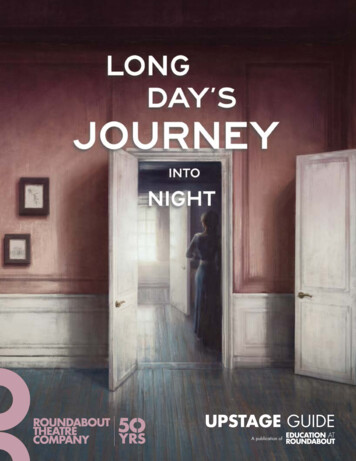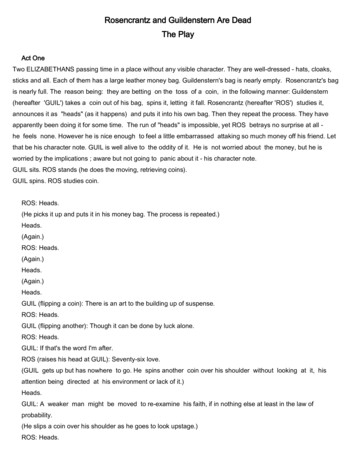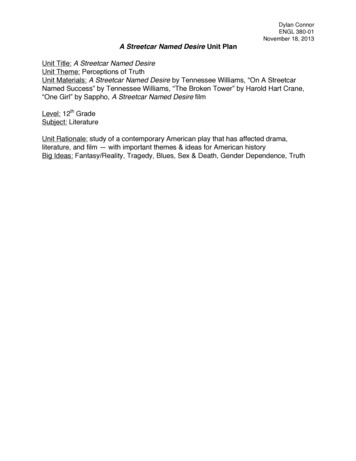
Transcription
UPSTAGE GUIDEA publication of
UPSTAGE CALLBOARDLong Day's Journey Into NightBy Eugene O’NeillDirected by Jonathan KentDrawing so heavily from the author’s personal history that it could only beproduced posthumously, the story of the Tyrone family and their battle to unearth—and conceal—a lifetime of secrets continues to reveal itself to audiences as one ofthe most profound and powerful plays ever brought to the stage.a note from Artistic Director Todd HaimesI don’t think it’s particularly controversial to call Long Day’s Journey IntoNight a masterpiece. This piece redefined the genre of the “family play,” depictinga mother, father, and sons with such unabashed truth that audiences at the timewere utterly shocked. It was called “barbaric and unrelenting,” “dark, harrowing,”“frenzied, fearful,” and “riotously funny.” This play was unlike anything thathad been seen before. By setting a new bar for plays about families, we haveO’Neill and this piece to thank for so many of the great works that have come tothe stage in the years that followed. From Neil Simon’s Brighton Beach Memoirs toTracy Letts’s August: Osage County; from Lorraine Hansberry’s A Raisin in the Sunto Stephen Karam’s The Humans, the influence of Eugene O’Neill is easy to see. Thetruthfulness of his work scared those early audiences into silence, but it gavefuture playwrights permission to be heard.whenwherewhoA day in August,1912.The Living-Room ofthe Tyrones’ summer home inNew London, Connecticut.James Tyrone: Afather and husbandMary Cavan Tyrone: His wifeJames Tyrone, Jr.: Their eldersonEdmund Tyrone:Their younger sonCathleen: The family’s maid2ROUNDABOUT THEATRE COMPANY
TABLE OF CONTENTSInterview with Director Jonathan Kent . Page 4-5Eugene O’Neill: Friend, Craftsman, Honorary Swede.Page 6Interview with O’Neill Scholar Robert Richter.Page 7James Tyrone: The Old Man. Page 8-9Mary Cavan Tyrone: A Shy Convent-Girl. Page 10-11Jamie Tyrone: That Drunken Loafer. Page 12-13Edmund Tyrone: Mama’s Baby, Papa’s Pet.Page 14Interview with Actor John Gallagher, Jr.Page 15The O’Neill Legacy. Page 16-17Designer Statements. Page 18-19Pre-Show Activities.Page 20Post-Show Activities.Page 21Glossary and Resources.Page 22About Roundabout .Page 23UPSTAGE CONTRIBUTORSMANAGINGEDITORS:Kim OriaEducation ProgramManagerJill RafsonDirector of NewPlay DevelopmentINTERVIEWS:WRITERS:Ted SodEducation DramaturgJason JacobsTeaching ArtistGRAPHIC DESIGNER:Leah ReddyTeaching ArtistDarren MelchiorreManager, Design andProductionOlivia O’ConnorArtistic AssociateEDUCATION STAFF:Sarah KutnowskyEducation ApprenticeBen HooverArtistic ApprenticeJennifer DiBellaDirector of EducationMitch MattsonAssistant Director ofEducationPaul BrewsterSenior Manager ofEducation ProgramsKaren LoftusEducation Program ManagerAbby CaseEducation CoordinatorKatlyn RapiniEducation AssistantSamantha JacobEducation ApprenticeCopyright 2016 Roundabout Theatre Company, Inc. All rights reserved.LONG DAY'S JOURNEY INTO NIGHT UPSTAGE GUIDE3
INTERVIEW WITH DIRECTORJONATHAN KENTEducation Dramaturg Ted Sod talked to director Jonathan Kentabout his work on Long Day’s Journey Into Night.Ted Sod: Where were you born and educated? When and why didyou decide to direct for the stage?Jonathan Kent: I was brought up in South Africa, in Cape Town,and had originally thought of becoming a painter. I had never metanyone in theatre and I just felt people in theatre were different fromme for some reason. I was very naïve. I got to London and to mysurprise got into a drama school and became an actor. I only starteddirecting in 1990 when I took over the Almeida, which, at that time,was a receiving house and not a producing house at all. There wasno money, so we went out and raised it. At that point, I was intendingreally to produce and be an occasional actor. But, through a set ofcircumstances I ended up directing the second production—Ibsen’sWhen We Dead Awaken—and I remember very clearly directingClaire Bloom on the second day of rehearsal and suddenly thinking, “Idon’t care what anybody else thinks, this is what I should be doing.”It brought together so many elements of my life. I’m the son of anarchitect, the brother of an architect, I was interested in becoming apainter, and I was an actor. And so all these pursuits suddenly cametogether and made sense of directing, for me. I’ve directed for 26 yearsnow. It’s alarming how quickly time goes by.TS: Did you have any teachers when you were studying acting whowere influential?JK: I was always interested—sometimes to my detriment as an actor—in the direction of the play. I was interested in the whole, rather thanjust my own performance. I didn’t have a teacher per se, but when Ileft drama school, I went to a repertory company in Scotland called theGlasgow Citizens Theatre. There was a very remarkable stage designerand director there named Philip Prowse. I remember him saying tome, “Why don’t you direct?” It would have saved a lot of time if I hadlistened to him. On the other hand, I’m glad of my years as an actor.Because, as I’ve said, it feeds into my life as a director.TS: Was watching the film version with Ralph Richardson and KatharineHepburn of any value?JK: Yes, it all helps. Laurence Olivier did a production here in Londonwhich was very admired. There was the production with Jack Lemmonwhich I saw on stage and on film with Peter Gallagher and KevinSpacey playing Edmund and Jamie, respectively. But again, it’s reallygetting these particular personalities into rehearsal and discovering thespecific dynamic among them.TS: Why did you choose to direct Long Day’s Journey Into Night?JK: It’s unanswerably one of the great plays of the 20th century andcertainly one of the greatest—if not the greatest—American play. Theopportunity to direct a play of such emotional complexity, depth, andpower would be impossible to turn down. It’s the template for a wholegenre of American theatre, the dysfunctional family play. You see somuch of this seminal play in other works, and it is fascinating to getback to the source.TS: Is there any challenge in directing a play that is obviouslyautobiographical and based on real people?TS: What kind of preparation will you have to do to direct this?TS: What about the Irishness of the play? Is that important to your workin rehearsal?JK: I’ve read biographies of O’Neill, and I know quite a bit of his work.I produced The Iceman Cometh when I was at the Almeida with KevinSpacey in the lead. But in the end, it is working with the five actors ina room. It is the exploration of those dysfunctional relationships—lostin a miasma of addiction and the fog of the drink—that will be mostimportant. The work lies within, and among, the actors in therehearsal room.4ROUNDABOUT THEATRE COMPANYJK: It is the most overtly autobiographical of all his plays, but in the endit’s fractured through the prism of his genius. He elevates the specificinto something much more universal and theatrically potent than just aseries of snapshots of a family in New London, Connecticut. It ceasessimply to be biography—it is transmuted into art.JK: The Irishness is important, the knowledge of it. It is a constantundertone, but these are first and second generation Americans whohave made good in the New World, while still haunted by the mythof Ireland.
“It’s a claustrophobic, compulsive portrait of four people in a kind of hell,clinging to the edge of the world over the course of a single day.”John Gallagher, Jr., Michael Shannon, Gabriel Bryne and Jessica Lange in Long Day's Journey Into NightTS: Why do you think this is such a compelling play for audiences?TS: How do you keep yourself inspired as an artist?JK: It’s a claustrophobic, compulsive portrait of four people in a kindof hell, clinging to the edge of the world over the course of a singleday. It has the inexorable drive of great tragedy. There is the additionalelement of Edmund, who, while part of the family, in the end is goingto go on and write about them. That is going to be his exorcism and,ironically, what will also preserve them forever.JK: I direct three Chekhov plays on stage later this season at theNational. So I’ll do Eugene O’Neill followed by three Chekhovs—howcan you not be inspired? To be able to direct a Puccini opera andGypsy, and then Eugene O’Neill and Chekhov all in the last 18 monthsis an exhilarating privilege.TS: How will the play manifest itself visually? How are you collaboratingwith your design team?JK: This play exists in heightened naturalism. And I think it’s importantthat one gets the sense of never letting the four of them off the hook.What I think would be a mistake is end-stopping scenes. The wholeplay is dictated by the relentless movement of the sun over the course ofa day. They’re four people clinging to a raft of a house in New London.And the next day it will all begin again, in some way or another. I wantto visually allow that. Though it will be specific one also has to allowthe universal.TS: Do you have any advice for a young person who might wantto direct?JK: I think everybody takes an individual path towards it. It’s a veryinexact science, directing. I don’t believe particularly in a formula fordirecting, in the same way that there isn’t a formula for acting. Youdo, however, have to submerge your own ego. You start a rehearsalprocess with power and authority, but during the course of rehearsals,you hand the power across to the actors. So by the end of rehearsal,the actors hold the power of the play. I think that’s an important thing torealize. It’s about allowing the actors to discover it themselves and beeven better than they thought they could be. TS: Are you planning to use original music?JK: No, I’m going to use natural sound—of the sea, perhaps, and thewind. And maybe music or voices borne on the wind.LONG DAY'S JOURNEY INTO NIGHT UPSTAGE GUIDE5
EUGENE O’NEILL: FRIEND, CRAFTSMAN,HONORARY SWEDEThe story of Eugene O’Neill as a writer might begin in asanitorium in 1912. Born October 16, 1888 in New YorkCity, O’Neill grew up within the wings of theatres followinghis actor father across the nation on tour. Wanting littleto do with an actor’s career, he wandered through hisyounger life, dropping out of college, working inconsistentjobs, and literally taking to the sea as a working sailor.But during his recovery from tuberculosis in the sanitorium,O’Neill discovered August Strindberg, a Swedish playwrightknown for his early realistic plays like Miss Julie and latesurrealistic plays such as A Dream Play and To Damascus,each of which defies traditional norms of storytelling. Genewould go on to identify Strindberg as “my inspiration downall the years.” And in fact, had they been contemporaries,Strindberg may have found kinship in O’Neill, as Swedishaudiences adored him. After the premiere of Long Day’sJourney Into Night, a newspaper from Stockholm wouldpraise O’Neill as “the world’s last dramatist of the statureof Aeschylus and Shakespeare.” In Strindberg, O’Neillrecognized a similarity and discovered his own desire towrite works for the stage.And write he did. O’Neill wrote over 30 full-length plays,over 20 one-act plays, and The Last Will and Testament ofSilverdene Emblem O’Neill, a short essay written to comforthis wife Carlotta as their family dog, Emblem (known asBlemie), was dying. He won four Pulitzer Prizes, one eachfor Beyond the Horizon (his first play on Broadway), AnnaChristie (which Roundabout revived in 1992 with LiamNeeson and Natasha Richardson), Strange Interlude, andLong Day’s Journey Into Night (awarded posthumously).For his collected oeuvre, O’Neill won the Nobel Prize inLiterature (annually awarded by a Swedish committee)in 1936.O’Neill preferred to write his plays by hand, findingdictation and learning how to use typewriters difficult. Hewrote slowly but methodically, professing great appreciationfor rules of theatre: “There are as well-established rules forthe theatre as thereare for paintingand music. Theonly ones who cansuccessfully breakthe rules are thepeople who knowthem. A knowledgeof rules is necessary,6ROUNDABOUT THEATRE COMPANYeven if adhering to tradition is not.” He was a staunchplaywright and abhorred the influence of motion pictures onfads in playwriting, going on to write plays that developedon trends in the day but with a universal quality of realismthat Strindberg had mastered and then eschewed in his laterlife. O’Neill’s most well-known plays echo his real life. Theirnaturalistic style and personal stakes create an epic quality,one that is simultaneously fictional and based in the author’spersonal history. He said of The Iceman Cometh, written in1939, “it takes place for me in life not in a theatre.” It islikely he felt similarly about Long Day’s Journey Into Night.O’Neill also stirred within his friends a deep and intenseloyalty. Gene’s, as they referred to him, friends wouldshout his praises, such as from writer Stark Young who saidof O’Neill’s work, “at the heart of [the plays] we sensea pressure, a spasm of desire and sanity or torment andmadness that leaves us swearing by the author, going tohis aid.” Beneath O’Neill’s sometimes brutal face and maskof resigned sorrow would explode a broad smile. O’Neillwould say, “I was just thinking of the past.” And, afterviewing or reading his plays, so were we.
INTERVIEW WITH EUGENE O’NEILL SCHOLARROBERT RICHTEREducation Dramaturg Ted Sod sat down with Eugene O’NeillScholar Robert Richter to discuss the history of the MonteCristo Cottage.Ted Sod: Where were you educated, what is your job, and howdoes it involve the Monte Cristo Cottage?Robert Richter: As an undergraduate I went to Connecticut Collegeand majored in theatre and anthropology, and a number of yearslater I received a master’s degree in American Studies from WesleyanUniversity. My master’s thesis was on the maritime influences on EugeneO’Neill, which I expanded into a book published in 2004. The title isEugene O’Neill and Dat Ole Davil Sea, taking the quote from AnnaChristie. Throughout this time, I was also doing work with the MonteCristo Cottage, which is owned by the Eugene O’Neill Theater Center,which owns the cottage. My current position here at ConnecticutCollege is Director of Arts Programming, and in that capacity I overseethe college’s performing arts series and technical support for ourperformance venues and artist residencies. I also teach a seminaron Eugene O’Neill.TS: Tell us about Monte Cristo Cottage, which is the setting for not onlyLong Day’s Journey Into Night, but also Ah, Wilderness!RR: In 2000, a group of cultural organizations in the New London areadecided that they wanted to do a series of collaborative programmingon the theme of Eugene O’Neill’s New London. I was the director ofthis project, and it was part of my work at Connecticut College. Wepresented plays of O’Neill’s, readings of plays by authors who werecolleagues of his in Provincetown, concerts of music from the period—we had a lecture series, a whole slew of things, including a walkingtour. The culminating event was held at the Eugene O’Neill TheaterCenter in Waterford.That culminating event turned into the O’Neill Center’s annual EugeneO’Neill celebration, which is now held every fall at the Monte CristoCottage. The Center acquired the cottage in 1974.TS: Where is the cottage?RR: It’s in New London, overlooking New London Harbor. It’s on PequotAvenue, which is a road that basically runs from downtown and goesalong the Thames River. The river feeds out into Long Island Sound andthe open ocean. New London Harbor is the best natural deep-waterharbor on the Eastern seaboard of the United States. There was all ofthis traffic: naval, commercial, and fishing vessels were all coming andgoing from New London during O’Neill’s time there.TS: What is the history of the cottage as it relates to theO’Neill family?RR: O’Neill’s mother and father, Ella and James, first bought propertyin New London in 1884. They did not buy the current Monte CristoCottage house until 1886. But they bought two other properties, whichare next door. The O’Neills bought property in New London becauseElla’s mother had recently moved there. James O’Neill also had a friendthere that he’d met in New York, a man by the name of John McGinley,who worked in New London for one of the newspapers.They lived in one of the houses that they bought first and used theMonte Cristo Cottage as a rental property. Then James decided torenovate it, and they then moved into the Monte Cristo Cottage in1900. New London was their summer home. Because James was atouring actor, they had no other permanent home. They lived primarilyin residential hotels. Eugene and his brother Jamie were in boardingschool most of the time. Eugene went off to boarding school at theage of 7.The cottage was originally built around 1840, and it had a store onthe first floor and a residential apartment on the second floor. Also onthe property was a one-room schoolhouse. When James renovated,he had this one-room schoolhouse moved and incorporated it into thehouse. And that schoolhouse room is the primary setting for Long Day’sJourney Into Night.Quite often when I bring students there I have them look at the stairwayand the railing—there are things that are very much out of proportion.The stairway itself is not very large, but it has a very grand railing.By examining the stairway you can begin to see the shortcuts Jamestook in the renovation in order to save money. As Mary Tyrone says inLong Day’s Journey Into Night, it was really not a comfortable home.Even though there are lots of windows on the first floor, upstairs there’svery little natural light. And even with all of the windows on the firstfloor, as the day progresses and the sun moves from the east to thewest—the front of the house faces east—by afternoon the house isreally enveloped in darkness. There are no windows on the back of thehouse, so it is somewhat of a claustrophobic environment.TS: How many set designers make the trek to see that house?RR: Oh, a lot. There are a few designers that come every year, and Idon’t necessarily come in contact with them all. Many of them contactthe O’Neill Theater Center directly. There are a number of scholars andtheatre practitioners who visit the cottage annually, too. It is open to thegeneral public during the summer months and then by appointmentthe rest of the year. It really is a pilgrimage site and unlike any sitein the country. LONG DAY'S JOURNEY INTO NIGHT UPSTAGE GUIDE7
JAMES TYRONE: THE OLD MAN“He is by nature and preference a simple, unpretentious man, whose inclinations are still close to his humble beginnings andhis Irish farmer forebears. But the actor shows in all his unconscious habits of speech, movement and gesture. These have thequality of belonging to a studied technique.” (From O’Neill’s description of the character James Tyrone)Biographer Barbara Gelb has called the role of JamesTyrone “O'Neill's Lear,” because of the actions andemotions it challenges an actor to perform. While strongpaternal figures loom heavily in many of O’Neill’s plays, hisrobust characterization of Tyrone stands apart as his mostpowerful statement about his father, James O’Neill, and theircomplicated relationship.A RAGS-TO-RICHES TRAGEDYAlthough he became a successful American actor, JamesO'Neill lived his entire life haunted by a fear of poverty.Uncertainty remains about his actual birthdate, because hewas vague in talking about his past; he was probably bornon October 15th of 1845, in County Kilkenny, during theworst of the Irish potato blight. His father, Edmund, was apoor tenant farmer whose wife, Mary, was 17 years hisjunior. The family had five daughters and three sons, ofwhich James was the youngest.The O’Neills made a difficult sea voyage to America,arriving in Buffalo, New York when James was six. Like mostIrish immigrants, they confronted prejudice and disdain andcould find only the lowest paying jobs. Edmund became adock worker. After five years and the death of oldest sonRichard, Edmund abandoned his family and returned toIreland, where he died in 1862. Ten-year-old James wentto work in a machine shop to help support the family. Ashe watched friends and neighbors move to the poor house,James’s fear of poverty grew.His older sister, Josephine, was determined to improveconditions for her family. She married a successfulbusinessman and moved to Cincinnati, taking 16-year-oldJames along. Her husband gave James a position sellingmilitary uniforms in his store and hired a private tutor toeducate him. Like many success stories, James O’Neill roseas a result of hard work and some good luck.His theatre career began in 1867, when, responding toa friend’s dare, he took a job as an extra in a play. Hequickly discovered an inclination for acting, and the stagemanager recognized his talent. Over the next decade Jamesapprenticed with some of the great actors of the age: EdwinForrest, Joseph Jefferson, and Edwin Booth. He developed8ROUNDABOUT THEATRE COMPANYhis craft, overcame his Irish brogue, and memorized over 50roles—including most of Shakespeare’s heroes. His talent,good looks, and charm earned him the respect of his peersand popularity with audiences.James was well-liked by women, both onstage and off.One actress recalled, "When I played with other Romeos,I thought they would climb up the trellis to the balcony; butwhen I played with Jimmy O'Neill, I wanted to climb downthe trellis, into his arms." Fifteen-year-old Ella Quinlan, thedaughter of a Cleveland businessman, caught James’s eye.Two years later, they met again in New York and a longcourtship followed. Against her mother’s wishes, she marriedJames in 1877. By this time, he had become a leading manin a theatre company, earning an impressive 195 a week.Their newlywed happiness was soon jeopardized whenNettie Welsh, a former lover, brought a lawsuit claiming thatJames had already married her and fathered a 3-year-oldson. Welsh lost the case due to insufficient evidence, but thescandal hurt the marriage—even as it helped James’s box
"My father died broken, unhappy, intensely bitter, feeling that life was a damned hard billet to chew.This after.what the mob undoubtedly regard as a highly successful career." - Eugene O’Neilloffice appeal. James and Ella had three children: JamesJr., Edmund (who died of the measles as a toddler), andEugene, born in 1888. Despite Ella’s dislike of the theatricallifestyle and her long struggle with addiction, Jamesremained a devoted and faithful husband.In 1883, James first played Edmond Dantes in themelodrama The Count of Monte Cristo, based on AlexandreDumas’ novel. Over the next 30 years, he performed therole over 6,000 times and earned more than 800,000—a fortune for a man who started as a penniless immigrant.But it became a Faustian bargain: he had sold out artisticaspiration in exchange for financial security and felt trappedby the role. Still, he played Dantes until the productionfinally closed down in 1916. In 1920, with his self-esteembroken and his spirit destroyed, James O’Neill died ofintestinal cancer. SON OFMONTE CRISTOEugene O’Neill wasborn at the height ofhis father’s fame inThe Count of MonteCristo. Once his motherrecovered her strength,she and infant Eugenejoined James on theroad, and Eugene’searliest memories of hisfather were watchinghim play the role.Eugene spent his life,both as a son and asa playwright, trying tobreak away from the influence and memories of his fatherand Monte Cristo.O’Neill brought a subjective perspective when hedramatized his father. James O’Neill’s stinginess isdebatable (even if James Tyrone’s is not): many ofhis companions recalled him as a generous friend,and the O’Neill family lived relatively well. Financialsuccess allowed James to buy property in New London,Connecticut, including the cottage that was named afterthe play. In New York, the family stayed in luxuriousapartments and hotels, and James sent both sons toboarding schools and private colleges. James subsidizedEugene’s early playwriting years, even if he disparagedhis attempts at writing, and bought him a studio inProvincetown as a wedding gift. James did commit Eugeneto a cheap state sanitarium when he contracted tuberculosisin 1912. But Eugene rebelled and, after three days,his father moved him to private hospital, supported byphilanthropists. James may have been frustrated that, afterproviding his sons with education and career opportunities,they continued to depend on his financial support.With the breakout success of his play Beyond the Horizonin 1920, O’Neill and his father reconciled. James weptand beamed with pride as he watched the openingperformance. "Well, lad, I tried to drag you in by the backdoor of the theater and now you're on the stage," he toldhis son. James was diagnosed with cancer a few weekslater. Eugene was grateful for the chance to befriend hisfather at the end. For the first time, James confided inEugene his regret for capitulating to the easy success ofMonte Cristo. Eugene felt his father left him "a warningfrom the Beyond to remain true to the best that is in methough the heavens fall."LONG DAY'S JOURNEY INTO NIGHT UPSTAGE GUIDE9
MARY TYRONE: A SHY CONVENT-GIRLBut some day, dear, I will find it again—some day when you're all well, and I see you healthy and happy and successful,and I don't have to feel guilty any more—some day when the Blessed Virgin Mary forgives me and gives me back the faithin Her love and pity I used to have in my convent days, and I can pray to Her again when She sees no one in the worldcan believe in me even for a moment any more, then She will believe in me, and with Her help it will be so easy. I will hearmyself scream with agony, and at the same time I will laugh because I will be so sure of myself.—Mary TyroneEugene O’Neill used the character of Mary Cavan Tyrone towork through the ideologies and choices that shapedthe life of his own mother, Mary Ellen “Ella” QuinlanO’Neill. The two--woman and character--share a devoutCatholic upbringing, marriage to a traveling actor, and anaddiction to morphine. While O’Neill made changes to thedetails of his mother’s life to serve the play, it’s clear thatthe soul of Mary Tyrone’s journey is rooted in Ella O’Neill’slife experience.O’Neill describes Mary Tyrone in the summer of 1912 justas his mother was then: 54 years old, medium height, with astriking face. “Her nose is long and straight, her mouth widewith full, sensitive lips .Her dark brown eyes appear black.They are unusually large and beautiful, with black brownsand long curling lashes.”Ella O’Neill was born in New Haven, Connecticut, onAugust 13, 1857. Like Mary Tyrone, whose voice has“a touch of Irish lilt in it,” both of Ella’s parents were IrishCatholic immigrants. She was raised in St. Brigid’s Parishon the east side of Cleveland, Ohio. Her father’s successin business--an achievement for an immigrant in an eraof anti-Catholic, anti-Irish sentiment--allowed him to sendElla to private schools, first to Ursuline Academy near herparents’ home. The school was run by Ursuline nuns, anorder that focuses almost exclusively on the education ofgirls and places a high value on individual spiritual andacademic development and “the primacy of Hope.learningto trust in the Providence of God and the promise of a bettertomorrow.” There, young Ella would have attended mass,confession, novenas, benedictions, and adoration in theconvent chapel, passing hours staring at a painting ofthe Virgin Mary and the Christ child that hung in thesanctuary. She learned the difference between mortaland venial sins and developed a strong awareness ofher own transgressions.From Ursuline Academy, Ella was sent to the Convent of St.Mary in Notre Dame, Indiana. It was here that Ella, underthe tutelage of Mother Elizabeth, developed as a pianist,exactly as Mary Tyrone describes. O’Neill even retainsMother Elizabeth’s name. School was, for both Ella and10ROUNDABOUT THEATRE COMPANYMary, a happy time when faith and life were integrated andtheir creative talents nurtured.It’s at this point that Ella’s biography diverges from MaryTyrone’s backstory. In 1874, just prior to her graduation,Ella’s father died of tuberculosis aggravated by alcoholism,a habit he took up after his diagnosis. He left the familyquite well off, and young Ella persuaded her mother toaccompany her to New York to continue her music studies.It was there that she was re-introduced to James O’Neill,an actor and casual friend of her father’s that she first metas a teenager in Cleveland. At the ti
Long Day's Journey Into Night a masterpiece. This piece redefined the genre of the "family play," depicting a mother, father, and sons with such unabashed truth that audiences at the time . Into Night. Long Day's Journey Into Night and . . ROUNDABOUT THEATRE COMPANY, and when UPSTAGE GUIDE. A PDF. . . .










